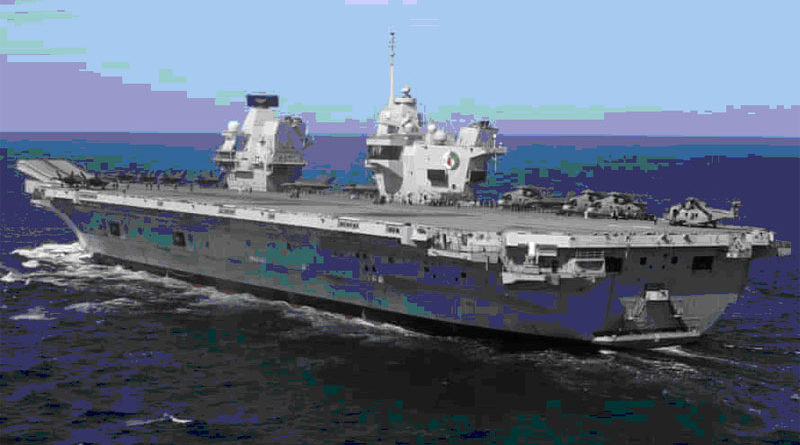The Observer View On The Royal Navy’s Operation In The South China Sea
01 Aug 21
China has said that aircraft carrier HMS Elizabeth’s foray into the South China Sea could ‘destabilise regional peace’. Sailing into imperial delusions is no way to run foreign policy.
What would Jack Aubrey have made of it? When Patrick O’Brian’s fictitious Royal Navy hero sailed HMS Surprise to the far side of the world, the enemy was the USS Norfolk, a lone American frigate marauding in the Pacific. Full speed ahead from the war of 1812, to 2021, and today’s maritime sparring partners are HMS Queen Elizabeth, Britain’s new £3bn aircraft carrier, and the Chinese People’s Liberation Army navy and its 360 “battle-force” ships.
It’s hardly an equal fight, though that would not have stopped Captain Aubrey. In any case, the government insists, slightly disingenuously, that it is not courting confrontation by parading modern-day gunboats under Beijing’s nose. The defence secretary, Ben Wallace, says the aim is “fly the flag for Global Britain”. Thus do deluded Brexiters spread their foolish, neo-imperial fantasies to points as distant as the hotly contested South China Sea.
Other reasons floated for this dangerous exercise include ensuring freedom of navigation in international sea lanes, coordinating operations with US and Nato allies and giving practical expression to Britain’s strategic “tilt to Asia”, as prescribed by the recent foreign and defence policy review. It’s true China has been taking liberties, turning reefs and sandbars into heavily fortified, artificial islands while illegally claiming the South China Sea area as its own.
But it was inevitable that Beijing would view the Queen Elizabeth’s foray, accompanied by a US destroyer, a Dutch frigate, and American F-35 combat aircraft, as a deliberately hostile, political provocation. It could “destabilise regional peace”, a spokesman warned. Britain was once again attempting to “ship back fortune and treasures plundered in Asia”, one commentator claimed.
Defence officials say the carrier strike group, the biggest naval force assembled since the Falklands war, will steer clear of the disputed Spratly and Paracel islands on its way north to Japan. But a lot could go wrong. Royal Navy vessels have a history of breaking down or running aground. An escort, HMS Diamond, a Type 45 destroyer, dropped out early on and sought repairs in Italy. And the Chinese military may decide to make a point of their own.
Latest reports say the Shandong, a Chinese aircraft carrier, is under way south of Hainan and could try to close on the British force. Analysts predict the navy’s capabilities will be tested by Chinese surface ships, over-flights and submarines playing “cat and mouse”. What if these high-risk games turn serious, by accident or design? Is Boris Johnson really ready for a head-on collision with China?
It’s typical of this prime minister that he is prepared to take such a gamble with other people’s lives. It is also deeply contradictory. In February, Johnson declared himself a “fervent Sinophile” keen to expand economic and trade links with Beijing. His government wrongly blocked a bid to give UK courts a say in determining if a state is committing genocide, as China is in Xinjiang.
Yet over the past year, Johnson has excluded Huawei from UK 5G markets, sought to reduce China’s role in nuclear power projects and imposed sanctions over human rights abuses in Hong Kong. At the recent G7 summit, he signed up to Joe Biden’s anti-Beijing “alliance of democracies” and is busily wooing India, China’s rival. Now comes this navy lark. Exactly what is Johnson’s China policy?
An even bigger question mark hangs over the still largely notional Asia-Pacific “tilt”. At bottom, this wheeze is dictated and distorted by a desperate need for post-Brexit trade. Yet Asia is not the place where we live. For those who have forgotten, that place is Europe and the North Atlantic seaboard. Politically and economically diminished, Britain and its pared-back armed services cannot afford to play global policeman on the far side of the world, as the US defence secretary politely hinted last week. Nor should it try. There are more pressing challenges, such as Russia, much closer to home.
To subscribe to Dominic Cummings’s breathless blog costs £10 a month. For less than half the price, you can become a Guardian supporter. This is also a publishing outfit generally sceptical about the leadership of the British government. But, unlike the Cummings account, the Guardian also offers alternative views, hundreds of articles every day (available free, as a public service), brilliant writing from people like Marina Hyde, Rafael Behr and John Crace. And you can’t blame us for Brexit.
So as you join us today from India, we have a small favour to ask.Tens of millions have placed their trust in the Guardian’s high-impact journalism since we started publishing 200 years ago, turning to us in moments of crisis, uncertainty, solidarity and hope. More than 1.5 million readers, from 180 countries, have recently taken the step to support us financially – keeping us open to all, and fiercely independent.
With no shareholders, we can set our own agenda and provide trustworthy journalism that’s free from commercial and political influence, offering a counterweight to the spread of misinformation. When it’s never mattered more, we can investigate and challenge without fear or favour.
Unlike many others, Guardian journalism is available for everyone to read, regardless of what they can afford to pay. We do this because we believe in information equality. Greater numbers of people can keep track of global events, understand their impact on people and communities, and become inspired to take meaningful action.
If there were ever a time to join us, it is now. Every contribution, however big or small, powers our journalism and sustains our future.
Courtesy: The Guardian

